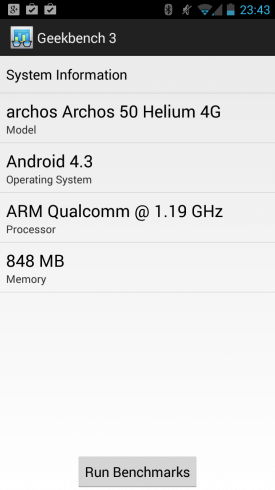 French firm Archos has been in the smartphone business since 2013 with a range of over 10 models but the phones are still relatively rare outside of their home country. At this year’s CES, Archos announced the Helium 45 and 50, affordable 4G smartphones with 4.5″ and 5″ screens respectively and Archos have kindly sent me a Helium 50 for review. Let’s take a look.
French firm Archos has been in the smartphone business since 2013 with a range of over 10 models but the phones are still relatively rare outside of their home country. At this year’s CES, Archos announced the Helium 45 and 50, affordable 4G smartphones with 4.5″ and 5″ screens respectively and Archos have kindly sent me a Helium 50 for review. Let’s take a look.
The Helium 50 doesn’t stray far from the classic smartphone form factor: it’s a rectangle with curved corners and there’s nothing really to make it stand out from the crowd – let’s say it could do with a bit more Gallic flair. Dimensions are 145 x 7.5 x 9 mm (5.7” x 2.8” x 0.35”) and weighs in at 160g. The build quality feels good and the rear shell clips on firmly.
No major surprises – head phone socket on top, volume rocker on left, power on the right and microUSB on the bottom right for charging. Oddly for a new smartphone model, the buttons at the bottom are fixed – they’re not the expected soft buttons – and one of them is a menu button too, which I believe is deprecated on the newer versions of Android.
Although a slim phone regardless, the camera isn’t quite flush with the back.
Perhaps slightly of note is that when you peek inside, between the microSD card slot and the SIM slot, there’s an empty slot that could potentially take a second SIM.
On paper, the Archos 50 is running Android 4.3 (Jelly Bean) on a 1.2 GHz quad-core Qualcomm ARM processor, partnered with an Adreno GPU driving a 5” 1280 x 720 (HD) screen with IPS. There’s 1 GB RAM, 8GB storage plus a microSD slot under the back cover. Not cutting edge specs by any means. Running Geekbench 3, the Helium 50 scores 341 in the Single-Core and 1156 in the Multi-Core test (cf 502 and 1499 for the Nexus 4). Disappointingly, although advertised as an 8 GB phone only 4 GB seems to be available to the user. Clearly a microSD should be an early purchase for new owners.
Initially, the smartphone’s performance seems good. Nova Launcher animations are smooth and games like Shardlands and Iron Man 3 look detailed and fluid with the Adreno GPU earning its keep. Unfortunately after using the phone for a time the lack of RAM becomes noticeable: while running apps work fine, returning to a previous app often requires the app to restart rather than smoothly switching back.
While talking about games, Ingress shows up the Helium’s GPS. While it’s accurate enough once settled, the GPS can be slow to update and sometimes stalls in one place for 20-odd seconds. It’s probably not so much of an issue with less demanding uses but in Ingress, fast and accurate GPS is critical to hacking and taking a portal.
On the plus side, Android seems to be mostly stock Jelly Bean with a few minor tweaks and some custom Archos apps for music, videos, FM radio and file management. The apps are good and in their favour is that they have built-in access to SMB shares and UPnP servers, which is a definite “thumbs up” from me. If interested, the Video Player is available from Google Play to try out on other phones.
Moving on to the camera, it has the most comprehensive range of settings that I’ve seen on any camera app – there are no less than three separate settings menus with several options that I didn’t have a clue about – “Max longshot NUM” anyone?! Despite the plethora of settings photographs were a little disappointing with the default settings. Even on “Super fine”, photos were a little grainy.
Finally, in terms of connectivity, 4G is nippy and watching films via Netflix or BBC’s iPlayer is feasible over 4G (but beware the volume caps!) There’s no doubt that this is the future and I can see that this will appeal to commuters on public transport who want to take advantage of the spare time. Obviously speed and 4G availability will be dependent on your mobile operator but I was pleased with EE’s performance when I was able to get a 4G signal.
In conclusion, I used the Archos Helium 50 4G as my daily phone for about a month and it works: it works fine. All the apps run, it has a big screen, it plays music and it’s well-built, but there’s no doubt that the uninspiring design and low RAM drop it down the leaderboard in comparison with other Android smartphones. On the flip side, the Helium 50 is a 4G smartphone with a 5″ screen, priced at only £199 off-contract which is attractive, especially when compared to other 4G phones at twice the price.
Thanks to Archos for the loan of the Helium 50.











